
Illustrative Math Alignment: Grade 8 Unit 7
Exponents and Scientific Notation
Lesson 4: Dividing Powers of 10
Use the following Media4Math resources with this Illustrative Math lesson.
| Thumbnail Image | Title | Body | Curriculum Topic |
|---|---|---|---|
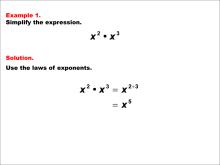
|
Math Examples Collection: The Laws of Exponents | OverviewThis comprehensive collection of 24 Math Examples focuses on the Laws of Exponents, providing educators with a rich resource to enhance their lesson plans. This set of downloadable images covers a wide range of skills related to exponent manipulation. |
Laws of Exponents |

|
Math Worksheet Collection: The Language of Math |
OverviewThis collection aggregates all the math worksheets around the topic of the Language of Math, or converting words into math expressions. There are a total of 264 worksheets. Each worksheet includes an answer key. This collection of resources is made up of downloadable PDF files that you can easily incorporate into your instruction.To download the full set of these resources, click on this link.
|
Place Value, Addition Facts to 25, Addition Facts to 100, Numerical and Algebraic Expressions, Numerical Expressions, Variable Expressions, Fractions and Mixed Numbers, Subtraction Facts to 25 and Subtraction Facts to 100 |

|
Math Quiz Collection: The Laws of Exponents |
OverviewThis collection aggregates all the math quizzes on this topic: The Laws of Exponents. There are a total of 3 resources. This collection of quizzes is made up of downloadable PDFs. To download the full set of these resources, click on this link.
|
Laws of Exponents |
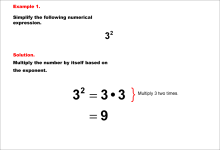
|
Math Examples Collection: Integer and Rational Exponents | OverviewThis collection from Media4Math on Integer and Rational Exponents offers a comprehensive set of examples on the topic of exponents. These examples gradually increase in complexity, covering a range of skills including integer and rational exponents, simplifying expressions, and applying exponent rules. Each example is supported by visual models to help simplify concepts, making it easier for students to understand the various properties of exponents. |
Numerical Expressions |

|
Math Definitions Collection: Exponential and Logarithmic Vocabulary | OverviewThis collection aggregates all the definition image cards around the topic of Exponential and Logarithmic vocabulary. There are a total of 11 terms. This collection of resources is made up of downloadable PNG files that you can easily incorporate into a presentation.
|
Applications of Exponential and Logarithmic Functions |
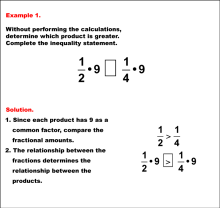
|
Math Examples Collection: Comparing Fraction Products | OverviewThe "Comparing Fractions Products" collection from Media4Math offers a comprehensive set of examples designed to enhance students' understanding of comparing products of fractions. This collection is structured to gradually increase in complexity, allowing students to build their skills progressively. By analyzing a variety of examples, students can develop a deeper conceptual understanding and improve their ability to compare fractional products effectively. |
Fractions and Mixed Numbers |
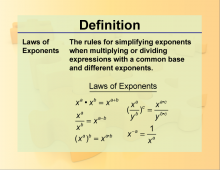
|
Definition--Exponential Concepts--Laws of Exponents | Definition--Exponential Concepts--Laws of Exponents
This is a collection of definitions related to exponential concepts. This includes exponential functions, equations, and properties of exponents. |
Applications of Exponential and Logarithmic Functions |

|
Definition--Exponential Concepts--Laws of Exponents | Definition--Exponential Concepts--Laws of Exponents
This is a collection of definitions related to exponential concepts. This includes exponential functions, equations, and properties of exponents. |
Applications of Exponential and Logarithmic Functions |
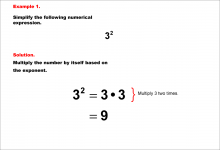
|
Math Example--Exponential Concepts--Integer and Rational Exponents--Example 1 | Math Example--Exponential Concepts--Integer and Rational Exponents--Example 1TopicExponents DescriptionShows Example 1 with the expression 32. The solution explains how to simplify by multiplying 3 by itself according to the exponent. Example 1: Simplify 32. Multiply 3 by itself two times: 3•3 = 9. |
Numerical Expressions |
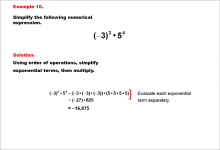
|
Math Example--Exponential Concepts--Integer and Rational Exponents--Example 10 | Math Example--Exponential Concepts--Integer and Rational Exponents--Example 10TopicExponents DescriptionShows Example 10 with the expression (-3)3•54. The solution uses order of operations to evaluate each term before multiplying. Example 10: Simplify (-3)3•54. Evaluate each exponential term separately, then multiply: -27•625= -16,875. |
Numerical Expressions |
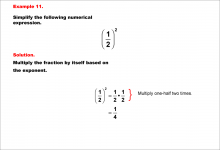
|
Math Example--Exponential Concepts--Integer and Rational Exponents--Example 11 | Math Example--Exponential Concepts--Integer and Rational Exponents--Example 11TopicExponents DescriptionExample 11 shows how to simplify (1/2)2. The image illustrates multiplying 1/2 by itself due to the exponent of 2. Example 11: Simplify (1/2)2. Multiply one-half two times. Solution: (1/2) * (1/2) = 1/4. |
Numerical Expressions |
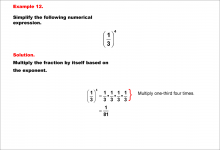
|
Math Example--Exponential Concepts--Integer and Rational Exponents--Example 12 | Math Example--Exponential Concepts--Integer and Rational Exponents--Example 12TopicExponents DescriptionExample 12 shows how to simplify (1/3)4. The image illustrates multiplying 1/3 four times due to the exponent of 4. Example 12: Simplify (1/3)4. Multiply one-third four times. Solution: (1/3) * (1/3) * (1/3) * (1/3) = 1/81. |
Numerical Expressions |
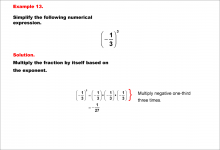
|
Math Example--Exponential Concepts--Integer and Rational Exponents--Example 13 | Math Example--Exponential Concepts--Integer and Rational Exponents--Example 13TopicExponents DescriptionExample 13 shows how to simplify (-1/3)3. The image illustrates multiplying -1/3 three times due to the exponent of 3. Example 13: Simplify (-1/3)3. Multiply negative one-third three times. Solution: (-1/3) * (-1/3) * (-1/3) = -1/27. |
Numerical Expressions |

|
Math Example--Exponential Concepts--Integer and Rational Exponents--Example 14 | Math Example--Exponential Concepts--Integer and Rational Exponents--Example 14TopicExponents DescriptionExample 14 shows how to simplify 2-1. The image illustrates rewriting 2-1 as the reciprocal of 2 raised to the first power. Example 14: Simplify 2-1. Negative exponents are written as reciprocals. Solution: 2-1 = 1/2. |
Numerical Expressions |
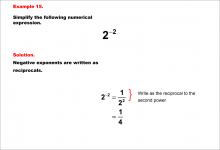
|
Math Example--Exponential Concepts--Integer and Rational Exponents--Example 15 | Math Example--Exponential Concepts--Integer and Rational Exponents--Example 15TopicExponents DescriptionExample 15 shows how to simplify 2-2. The image illustrates rewriting 2-2 as the reciprocal of 2 raised to the second power. Example 15: Simplify 2-2. Negative exponents are written as reciprocals. Solution: 2-2 = 1/(22) = 1/4. |
Numerical Expressions |
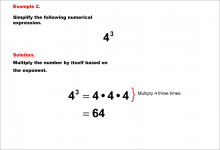
|
Math Example--Exponential Concepts--Integer and Rational Exponents--Example 2 | Math Example--Exponential Concepts--Integer and Rational Exponents--Example 2TopicExponents DescriptionShows Example 2 with the expression 43. The solution explains the simplification by multiplying 4 three times. Example 2: Simplify 43. Multiply 4 by itself three times: 4•4•4 = 64. In general, the topic of exponents involves understanding how repeated multiplication can be expressed more compactly. The examples provided in this collection allow students to see the step-by-step breakdown of how to simplify various exponential expressions, which can include positive and negative bases, fractional bases, and negative exponents. |
Numerical Expressions |
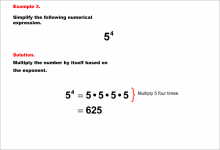
|
Math Example--Exponential Concepts--Integer and Rational Exponents--Example 3 | Math Example--Exponential Concepts--Integer and Rational Exponents--Example 3TopicExponents DescriptionShows Example 3 with the expression 54. The solution details multiplying 5 four times. Example 3: Simplify 54. Multiply 5 by itself four times: 5•5•5•5 = 625. In general, the topic of exponents involves understanding how repeated multiplication can be expressed more compactly. The examples provided in this collection allow students to see the step-by-step breakdown of how to simplify various exponential expressions, which can include positive and negative bases, fractional bases, and negative exponents. |
Numerical Expressions |
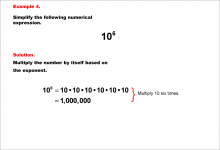
|
Math Example--Exponential Concepts--Integer and Rational Exponents--Example 4 | Math Example--Exponential Concepts--Integer and Rational Exponents--Example 4TopicExponents DescriptionShows Example 4 with the expression 106. The solution simplifies by multiplying 10 six times. Example 4: Simplify 106. Multiply 10 by itself six times: 10•10•10•10•10•10 = 1,000,000. |
Numerical Expressions |
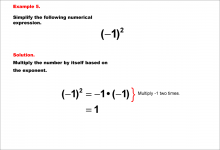
|
Math Example--Exponential Concepts--Integer and Rational Exponents--Example 5 | Math Example--Exponential Concepts--Integer and Rational Exponents--Example 5TopicExponents DescriptionShows Example 5 with the expression (-1)2. The solution explains the result by multiplying -1 by itself. Example 5: Simplify (-1)2. Multiply -1 by itself two times: (-1)•(-1) = 1. |
Numerical Expressions |
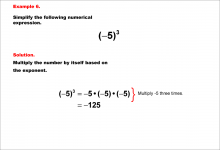
|
Math Example--Exponential Concepts--Integer and Rational Exponents--Example 6 | Math Example--Exponential Concepts--Integer and Rational Exponents--Example 6TopicExponents DescriptionShows Example 6 with the expression (-5)3. The solution demonstrates multiplying -5 three times. Example 6: Simplify (_5)3. Multiply -5 by itself three times: (-5)•(-5)•(-5) = -125. |
Numerical Expressions |

|
Math Example--Exponential Concepts--Integer and Rational Exponents--Example 7 | Math Example--Exponential Concepts--Integer and Rational Exponents--Example 7TopicExponents DescriptionShows Example 7 with the expression (-6)4. The solution explains multiplying -6 by itself four times. Example 7: Simplify (-6)4. Multiply -6 by itself four times: (-6)•(-6)•(-6)•(-6) = 1296. |
Numerical Expressions |
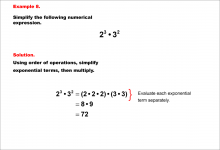
|
Math Example--Exponential Concepts--Integer and Rational Exponents--Example 8 | Math Example--Exponential Concepts--Integer and Rational Exponents--Example 8TopicExponents DescriptionShows Example 8 with the expression 23•32. The solution demonstrates using order of operations to simplify each term separately, then multiply. Example 8: Simplify 23•32. Evaluate each exponential term separately, then multiply: 8•9 = 72. |
Numerical Expressions |
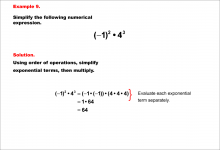
|
Math Example--Exponential Concepts--Integer and Rational Exponents--Example 9 | Math Example--Exponential Concepts--Integer and Rational Exponents--Example 9TopicExponents DescriptionShows Example 9 with the expression (-1)2•43. The solution explains simplifying each term individually before multiplying. Example 9: Simplify (-1)2•43. Evaluate each exponential term separately, then multiply: 1•64 = 64. |
Numerical Expressions |
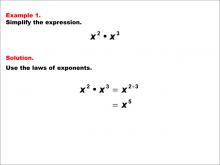
|
Math Example--Exponential Concepts--Laws of Exponents: Example 1 | Math Example--Exponential Concepts--Laws of Exponents: Example 1TopicExponents DescriptionThis example demonstrates the simplification of an expression using the laws of exponents. The problem involves simplifying x2 * x3, which results in x5 by applying the law of exponents for multiplication. This step-by-step solution helps students understand how to combine like terms with exponents. |
Laws of Exponents |
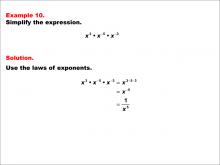
|
Math Example--Exponential Concepts--Laws of Exponents: Example 10 | Math Example--Exponential Concepts--Laws of Exponents: Example 10TopicExponents DescriptionThis example focuses on simplifying an expression with both positive and negative exponents. The problem involves simplifying x3 * x(-5) * x(-3), which results in x(-5) or 1/x5. This demonstrates how positive and negative exponents interact when multiplying terms with the same base, and how the result can be expressed as a fraction. |
Laws of Exponents |
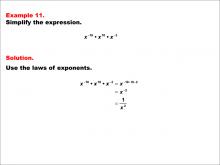
|
Math Example--Exponential Concepts--Laws of Exponents: Example 11 | Math Example--Exponential Concepts--Laws of Exponents: Example 11TopicExponents DescriptionThis example demonstrates the simplification of an expression with both positive and negative exponents, including a zero exponent. The problem involves simplifying x(-10) * x10 * x(-2), which results in x(-2) or 1/x2. This showcases how positive and negative exponents interact when multiplying terms with the same base, and how zero exponents affect the result. |
Laws of Exponents |
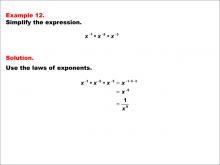
|
Math Example--Exponential Concepts--Laws of Exponents: Example 12 | Math Example--Exponential Concepts--Laws of Exponents: Example 12TopicExponents DescriptionThis example focuses on simplifying an expression with multiple negative exponents. The problem involves simplifying x(-1) * x(-5) * x(-3), which results in x(-9) or 1/x9. This demonstrates how negative exponents interact when multiplying terms with the same base, and how the result can be expressed as a fraction with a positive exponent in the denominator. |
Laws of Exponents |
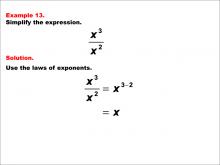
|
Math Example--Exponential Concepts--Laws of Exponents: Example 13 | Math Example--Exponential Concepts--Laws of Exponents: Example 13TopicExponents DescriptionThis example demonstrates the simplification of an expression involving division with exponents. The problem involves simplifying x3 / x2, which results in x. This showcases how exponents behave when dividing terms with the same base, illustrating the subtraction of exponents in division. |
Laws of Exponents |
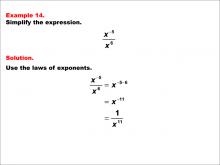
|
Math Example--Exponential Concepts--Laws of Exponents: Example 14 | Math Example--Exponential Concepts--Laws of Exponents: Example 14TopicExponents DescriptionThis example demonstrates the simplification of an expression involving division with negative exponents. The problem involves simplifying x(-5) / x6, which results in x(-11) or 1/x11. This showcases how negative and positive exponents interact when dividing terms with the same base, and how the result can be expressed as a fraction. |
Laws of Exponents |
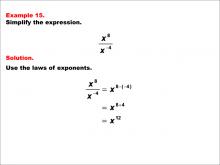
|
Math Example--Exponential Concepts--Laws of Exponents: Example 15 | Math Example--Exponential Concepts--Laws of Exponents: Example 15TopicExponents DescriptionThis example illustrates the simplification of an expression involving division with both positive and negative exponents. The problem involves simplifying x8 / x(-4), which results in x12. This demonstrates how positive and negative exponents interact when dividing terms with the same base, and how the result can yield a larger positive exponent. |
Laws of Exponents |

|
Math Example--Exponential Concepts--Laws of Exponents: Example 16 | Math Example--Exponential Concepts--Laws of Exponents: Example 16TopicExponents DescriptionThis example focuses on simplifying an expression with negative exponents in both the numerator and denominator. The problem involves simplifying x(-7) / x(-5), which results in x(-2) or 1/x2. This demonstrates how negative exponents interact when dividing terms with the same base, and how the result can be expressed as a fraction. |
Laws of Exponents |
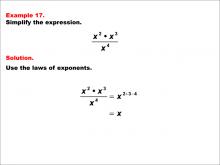
|
Math Example--Exponential Concepts--Laws of Exponents: Example 17 | Math Example--Exponential Concepts--Laws of Exponents: Example 17TopicExponents DescriptionThis example demonstrates the simplification of an expression involving multiplication and division with exponents. The problem involves simplifying (x2 * x3) / x4, which results in x. This showcases how exponents behave when multiplying and dividing terms with the same base, illustrating the addition and subtraction of exponents in a single expression. |
Laws of Exponents |
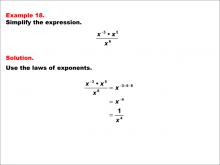
|
Math Example--Exponential Concepts--Laws of Exponents: Example 18 | Math Example--Exponential Concepts--Laws of Exponents: Example 18TopicExponents DescriptionThis example focuses on simplifying an expression involving multiplication and division with both positive and negative exponents. The problem involves simplifying (x-3 * x5) / x6, which results in x-4 or 1/x4. This demonstrates how positive and negative exponents interact when multiplying and dividing terms with the same base, and how the result can be expressed as a fraction. |
Laws of Exponents |
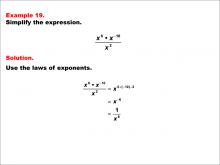
|
Math Example--Exponential Concepts--Laws of Exponents: Example 19 | Math Example--Exponential Concepts--Laws of Exponents: Example 19TopicExponents DescriptionThis example demonstrates the simplification of an expression involving multiplication and division with both positive and negative exponents. The problem involves simplifying (x6 * x-10) / x2, which results in x-6 or 1/x6. This showcases how positive and negative exponents interact when multiplying and dividing terms with the same base, and how the result can be expressed as a fraction. |
Laws of Exponents |

|
Math Example--Exponential Concepts--Laws of Exponents: Example 2 | Math Example--Exponential Concepts--Laws of Exponents: Example 2TopicExponents DescriptionThis example focuses on simplifying an expression with negative exponents using exponent rules. The problem involves simplifying x(-3) * x4, which results in x1 or simply x. This demonstrates how positive and negative exponents interact when multiplying terms with the same base. |
Laws of Exponents |
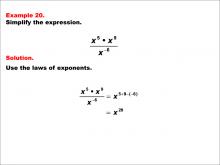
|
Math Example--Exponential Concepts--Laws of Exponents: Example 20 | Math Example--Exponential Concepts--Laws of Exponents: Example 20TopicExponents DescriptionThis example demonstrates the simplification of an expression involving multiplication and division with both positive and negative exponents. The problem involves simplifying (x5 * x9) / x-6, which results in x20. This showcases how positive and negative exponents interact when multiplying and dividing terms with the same base, and how dividing by a negative exponent can lead to a larger positive exponent. |
Laws of Exponents |
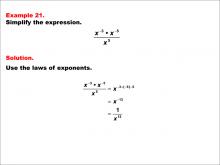
|
Math Example--Exponential Concepts--Laws of Exponents: Example 21 | Math Example--Exponential Concepts--Laws of Exponents: Example 21TopicExponents DescriptionThis example focuses on simplifying an expression involving multiplication and division with negative exponents. The problem involves simplifying (x(-3) * x(-5)) / x5, which results in 1/x13. This demonstrates how negative exponents interact when multiplying and dividing terms with the same base, and how the result can be expressed as a fraction with a positive exponent in the denominator. |
Laws of Exponents |
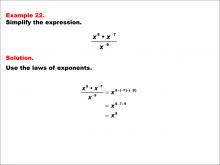
|
Math Example--Exponential Concepts--Laws of Exponents: Example 22 | Math Example--Exponential Concepts--Laws of Exponents: Example 22TopicExponents DescriptionThis example demonstrates the simplification of an expression involving multiplication and division with both positive and negative exponents. The problem involves simplifying (x6 * x(-7)) / x(-9), which results in x8. This showcases how positive and negative exponents interact when multiplying and dividing terms with the same base, and how dividing by a negative exponent can lead to a positive result. |
Laws of Exponents |
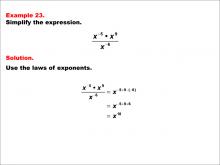
|
Math Example--Exponential Concepts--Laws of Exponents: Example 23 | Math Example--Exponential Concepts--Laws of Exponents: Example 23TopicExponents DescriptionThis example focuses on simplifying an expression involving multiplication and division with both positive and negative exponents. The problem involves simplifying (x(-5) * x9) / x(-6), which results in x10. This demonstrates how positive and negative exponents interact when multiplying and dividing terms with the same base, and how dividing by a negative exponent can lead to a larger positive exponent. |
Laws of Exponents |
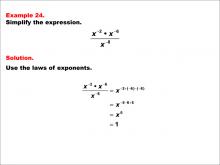
|
Math Example--Exponential Concepts--Laws of Exponents: Example 24 | Math Example--Exponential Concepts--Laws of Exponents: Example 24TopicExponents DescriptionThis example demonstrates the simplification of an expression involving multiplication and division with negative exponents. The problem involves simplifying (x(-2) * x(-6)) / x(-8), which results in 1. This showcases how negative exponents interact when multiplying and dividing terms with the same base, and how they can cancel out to yield a result of 1. |
Laws of Exponents |
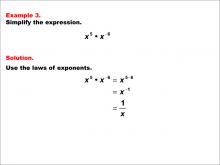
|
Math Example--Exponential Concepts--Laws of Exponents: Example 3 | Math Example--Exponential Concepts--Laws of Exponents: Example 3TopicExponents DescriptionThis example demonstrates the simplification of an expression resulting in a negative exponent. The problem involves simplifying x5 * x(-6), which results in x(-1) or 1/x. This showcases how positive and negative exponents interact and how the result can be expressed as a fraction. |
Laws of Exponents |

|
Math Example--Exponential Concepts--Laws of Exponents: Example 4 | Math Example--Exponential Concepts--Laws of Exponents: Example 4TopicExponents DescriptionThis example focuses on simplifying an expression with two negative exponents, resulting in a fraction. The problem involves simplifying x(-10) * x(-7), which results in x(-17) or 1/x17. This demonstrates how negative exponents combine and how the result can be expressed as a fraction with a positive exponent. |
Laws of Exponents |
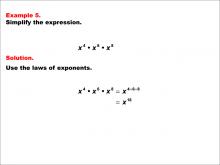
|
Math Example--Exponential Concepts--Laws of Exponents: Example 5 | Math Example--Exponential Concepts--Laws of Exponents: Example 5TopicExponents DescriptionThis example demonstrates the simplification of an expression using exponents with multiple terms. The problem involves simplifying x4 * x6 * x8, which results in x18. This showcases how the exponents of terms with the same base can be added when multiplying. |
Laws of Exponents |
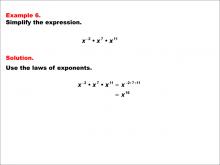
|
Math Example--Exponential Concepts--Laws of Exponents: Example 6 | Math Example--Exponential Concepts--Laws of Exponents: Example 6TopicExponents DescriptionThis example focuses on simplifying an expression with both negative and positive exponents. The problem involves simplifying x(-2) * x7 * x11, which results in x16. This demonstrates how positive and negative exponents interact when multiplying terms with the same base, and how they can be combined to yield a single positive exponent. |
Laws of Exponents |
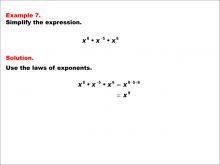
|
Math Example--Exponential Concepts--Laws of Exponents: Example 7 | Math Example--Exponential Concepts--Laws of Exponents: Example 7TopicExponents DescriptionThis example demonstrates the simplification of an expression using both positive and negative exponents. The problem involves simplifying x8 * x(-5) * x6, which results in x9. This showcases how positive and negative exponents interact when multiplying terms with the same base, and how they can be combined to yield a single positive exponent. |
Laws of Exponents |
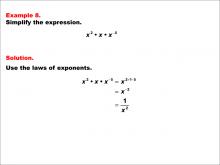
|
Math Example--Exponential Concepts--Laws of Exponents: Example 8 | Math Example--Exponential Concepts--Laws of Exponents: Example 8TopicExponents DescriptionThis example focuses on simplifying an expression with negative exponents and converting it to a fraction. The problem involves simplifying x2 * x * x(-5), which results in 1/x2. This demonstrates how positive and negative exponents interact when multiplying terms with the same base, and how the result can be expressed as a fraction. |
Laws of Exponents |
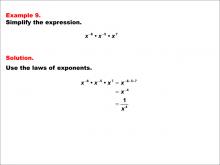
|
Math Example--Exponential Concepts--Laws of Exponents: Example 9 | Math Example--Exponential Concepts--Laws of Exponents: Example 9TopicExponents DescriptionThis example demonstrates the simplification of an expression with multiple negative exponents and one positive exponent. The problem involves simplifying x(-6) * x(-5) * x7, which results in x(-4) or 1/x4. This showcases how positive and negative exponents interact when multiplying terms with the same base, and how the result can be expressed as a fraction. |
Laws of Exponents |
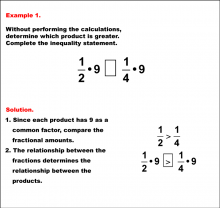
|
Math Example--Fraction Properties--Comparing Fraction Products: Example 1 | Comparing Fraction Products: Example 1TopicComparing Fractions |
Fractions and Mixed Numbers |
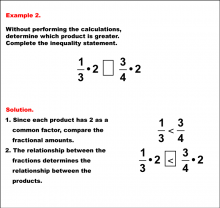
|
Math Example--Fraction Properties--Comparing Fraction Products: Example 2 | Comparing Fraction Products: Example 2TopicComparing Fractions DescriptionThis example illustrates the process of comparing the products of fractions. The image shows a scenario where two fractions are multiplied and their products are compared to determine which is greater. The mathematical concept involves understanding how to multiply fractions and compare the resulting products. Key skills include fraction multiplication, simplification, and comparison. Solving this problem often requires an algorithmic method where fractions are multiplied and then compared, or a visual model might be employed to provide a clearer understanding of the size of each product relative to the other. |
Fractions and Mixed Numbers |
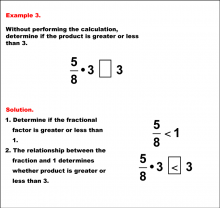
|
Math Example--Fraction Properties--Comparing Fraction Products: Example 3 | Comparing Fraction Products: Example 3TopicComparing Fractions DescriptionThis example focuses on comparing the products of fractions. The image depicts a fraction product compared to a whole number. The concept involves multiplying fractions and comparing the results to see which is larger or smaller. Skills required include multiplying fractions, simplifying them, and comparing the numerical outcomes. This problem can be solved using a straightforward algorithm where each fraction is multiplied, and the products are compared, or through a visual model that helps illustrate the relative sizes and relationships between the products. |
Fractions and Mixed Numbers |